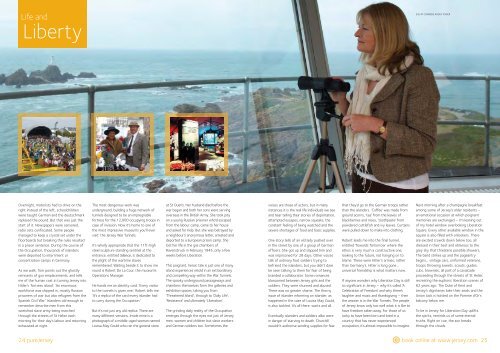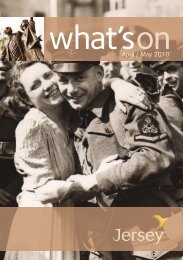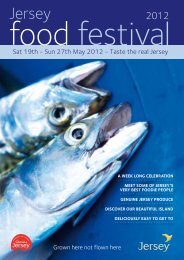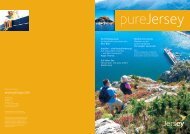Spring-Summer Pure Jersey Part 1 with adverts:jersey Cover AW
Spring-Summer Pure Jersey Part 1 with adverts:jersey Cover AW
Spring-Summer Pure Jersey Part 1 with adverts:jersey Cover AW
You also want an ePaper? Increase the reach of your titles
YUMPU automatically turns print PDFs into web optimized ePapers that Google loves.
Life and<br />
Liberty<br />
LIBERATION FESTIVAL LIBERATION DAY REVISITED THE JERSEY WAR TUNNELS<br />
Overnight, motorists had to drive on the<br />
right instead of the left, schoolchildren<br />
were taught German and the deutschmark<br />
replaced the pound. But that was just the<br />
start of it. Newspapers were censored,<br />
radio sets confiscated. Some people<br />
managed to keep a crystal set under the<br />
floorboards but breaking the rules resulted<br />
in a prison sentence. During the course of<br />
the Occupation, thousands of islanders<br />
were deported to internment or<br />
concentration camps in Germany.<br />
As we walk, Tom points out the ghostly<br />
remnants of gun emplacements, and tells<br />
me of the human cost in turning <strong>Jersey</strong> into<br />
Hitler’s ‘fortress island’. ‘An enormous<br />
workforce was shipped in, mostly Russian<br />
prisoners of war but also refugees from the<br />
Spanish Civil War.’ Islanders old enough to<br />
remember describe men from this<br />
wretched slave army being marched<br />
through the streets of St Helier each<br />
morning for their day’s labour and returning<br />
exhausted at night.<br />
The most dangerous work was<br />
underground, building a huge network of<br />
tunnels designed to be an impregnable<br />
fortress for the 12,000 occupying troops in<br />
case of invasion. Now it’s home to one of<br />
the most impressive museums you’ll ever<br />
visit: the <strong>Jersey</strong> War Tunnels.<br />
It’s wholly appropriate that the 11ft-high<br />
steel sculpture standing sentinel at the<br />
entrance, entitled Silence, is dedicated to<br />
the plight of the wartime slaves<br />
remembered. Waiting beside it to show me<br />
round is Robert De La Cour, the museum’s<br />
Operations Manager.<br />
He hands me an identity card. ‘Every visitor<br />
to the tunnels is given one,’ Robert tells me.<br />
‘It’s a replica of the card every islander had<br />
to carry during the Occupation.’<br />
But it’s not just any old replica. There are<br />
many different versions. Inside mine is a<br />
photograph of a middle-aged woman named<br />
Louisa May Gould who ran the general store<br />
at St Ouen’s. Her husband died before the<br />
war began and both her sons were serving<br />
overseas in the British Army. She took pity<br />
on a young Russian prisoner who’d escaped<br />
from the labour camp, came to her house<br />
and asked for help. But she was betrayed by<br />
a neighbour’s anonymous letter, arrested and<br />
deported to a European prison camp. She<br />
lost her life in the gas chambers of<br />
Ravensbruck in February 1945, only a few<br />
weeks before Liberation.<br />
This poignant, heroic tale is just one of many<br />
island experiences retold in an extraordinary<br />
and compelling way <strong>with</strong>in the War Tunnels.<br />
The spooky underground passageways and<br />
chambers themselves form the galleries and<br />
exhibition spaces, taking you from<br />
‘Threatened Island’, through to ‘Daily Life’,<br />
‘Resistance’ and ultimately ‘Liberation’.<br />
The grinding daily reality of the Occupation<br />
emerges through the eyes not just of <strong>Jersey</strong><br />
men, women and children but slave workers<br />
and German soldiers too. Sometimes the<br />
voices are those of actors, but in many<br />
instances it is the real life individuals we see<br />
and hear telling their stories of deportation,<br />
attempted escapes, narrow squeaks, the<br />
constant feeling of being watched and the<br />
severe shortages of food and basic supplies.<br />
One story tells of an old lady pushed over<br />
in the street by one of a group of German<br />
officers. She got up and slapped him and<br />
was imprisoned for 28 days. Other voices<br />
talk of ordinary foot soldiers trying to<br />
befriend the islanders, but you didn’t dare<br />
be seen talking to them for fear of being<br />
branded a collaborator. Some romances<br />
blossomed between <strong>Jersey</strong> girls and the<br />
soldiers. They were shunned and abused.<br />
There was no greater shame. The thorny<br />
issue of islander informing on islander, as<br />
happened in the case of Louisa May Gould,<br />
is also tackled. It’s all there, warts and all.<br />
Eventually islanders and soldiers alike were<br />
in danger of starving to death. Churchill<br />
wouldn’t authorise sending supplies for fear<br />
that they’d go to the German troops rather<br />
than the islanders. ‘Coffee’ was made from<br />
ground acorns, ‘tea’ from the leaves of<br />
blackberries and roses, ‘toothpaste’ from<br />
powdered cuttlefish and ivy leaves. Curtains<br />
were pulled down to make into clothing.<br />
Robert leads me into the final tunnel,<br />
entitled ‘Towards Tomorrow’ where the<br />
ethos is very much a constructive one,<br />
looking to the future, not hanging on to<br />
blame. These were Hitler’s armies, rather<br />
than Germany’s. Hitler is long gone…<br />
universal friendship is what matters now.<br />
If anyone wonders why Liberation Day is still<br />
so significant in <strong>Jersey</strong> – why it’s called ‘A<br />
Celebration of Freedom’ and why there’s<br />
laughter and music and thanksgiving – then<br />
the answer is in the War Tunnels. The people<br />
of <strong>Jersey</strong> know only too well what it is like to<br />
have freedom taken away. For those of us<br />
lucky to have been born and bred in a<br />
country that has never experienced<br />
occupation, it’s almost impossible to imagine.<br />
SUE AT CORBIÈRE RADIO TOWER<br />
Next morning after a champagne breakfast<br />
among some of <strong>Jersey</strong>’s older residents –<br />
an emotional occasion at which poignant<br />
memories are exchanged – I’m leaning out<br />
of my hotel window overlooking Liberation<br />
Square. Every other available window in the<br />
square is also filled <strong>with</strong> onlookers. There<br />
are excited crowds down below too, all<br />
dressed in their best and oblivious to the<br />
grey sky that threatens possible showers.<br />
The band strikes up and the pageantry<br />
begins… vintage cars, uniformed veterans,<br />
troops throwing sweets, scouts, guides,<br />
cubs, brownies, all part of a cavalcade<br />
proceeding through the streets of St Helier,<br />
recreating the euphoric liberation scenes of<br />
62 years ago. The Duke of Kent and<br />
<strong>Jersey</strong>’s dignitaries take their seats and the<br />
Union Jack is hoisted on the Pomme d’Or’s<br />
balcony below me.<br />
To be in <strong>Jersey</strong> for Liberation Day uplifts<br />
the spirits, reminds us of some eternal<br />
truths. Right on cue, the sun breaks<br />
through the clouds.<br />
24 pure<strong>Jersey</strong> 1 book online at www.<strong>jersey</strong>.com 25
















